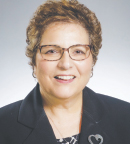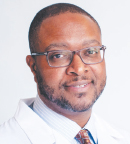2018–2019 ASCO President Monica M. Bertagnolli, MD, FACS, FASCO, is putting the words of her presidential theme— “caring for every patient, learning from every patient” —into action. During her term, she and other ASCO leaders will be traveling to local communities around the United States to moderate question-and-answer sessions with patients, survivors, caregivers, and oncology professionals. Providers will offer expert answers to patient questions and learn about the vital needs of patients in these communities. Members who participate in these town hall sessions, “ASCO in the Community: Listening and Learning From Our Patients,” will share the knowledge they’ve gained in a series of blog posts on ASCO Connection throughout the year. They will also share takeaways for patients on Cancer.Net, ASCO’s patient information website. This post from ASCO Connection details the lessons learned from the first town hall, which took place in Marietta, Ohio, in August 2018.

Electra D. Paskett, PhD

Colin D. Weekes, MD, PhD
What was your role in the town hall?
Electra Paskett: I helped arrange the town hall and other discussions with patients and providers, as I have conducted research and worked with Appalachian community members since 2003.
Colin Weekes: I was present as a representative of ASCO and a guest of the health-care providers of Appalachia and Dr. Paskett. I was on the panel of speakers at the town hall meeting along with Dr. Bertagnolli.
What is the cancer landscape in rural Ohio, where the town hall took place?
EP: The federally designated Appalachian region has areas of high poverty and low resources, including health care. Demographics in the Ohio Appalachian area (compared to the overall U.S. population) are low income, high poverty, lower education, white, higher smoking, higher cancer incidence and mortality rates, higher obesity, and lower physical activity. Challenges include low resources, transportation issues, long distances to travel for care, lack of access to high-speed Internet and connectivity, not all specialties available locally, and inability to always provide charity care to all who need it.
CW: This is a rural part of the United States with limited opportunity for jobs and education. This is a very poor part of the country, where resources for health care and overall life are very limited. This makes obtaining appropriate cancer care a challenge. This ranges all the way from cancer screening to cancer therapy. The people of the area are very proud and self-motivated with a strong sense of “family”—nuclear family as well as the larger community as a whole. This is a double-edged sword, as there is a reluctance to trust and seek the help of non-Appalachian individuals.
In today’s society, there is the mindset of a “quick fix”; however, true impact on cancer care in Appalachia has taken a sustained effort now going on 2 decades.
The biggest challenge to providing/accessing high-quality cancer care is economics. The individual does not have the finances to seek out optimal care, and the health-care system lacks resources to develop basic programs to help the people of the area. I was struck by the fact that a county health-care center that we visited needs $3,000 to make infrastructure repairs to the building as part of maintaining accreditation and was concerned about trying to find the money. That is a lot of money when you don’t have it but is a small amount of money when considering the larger health-care economy. This made me think about how we can more effectively utilize health-care dollars. In other words, a little can go a long way when allocated in an appropriate manner. In this particular case, it would be devastating for the county if this health-care center lost its accreditation. A health-care worker at that facility was so dedicated to the patients and the people she served. This was a common theme among all of the facilities we visited.
What were your key takeaways for medical professionals from the town hall discussions?
EP: The town hall was very enlightening for patients, community members, and providers. Community cancer centers do provide care for the majority of patients in this region. Patients, however, still have barriers to care, including finances, transportation, information, and more. Even if these barriers can be addressed, disparities may increase with newer treatments that are only available outside of tertiary centers.
Community cancer centers should form a network locally to work together to solve problems and obtain assistance from university-based centers to help them be able to comprehensively treat patients in the community, including patient-directed resources.
CW: This visit solidified some ideas that I had going into the experience as well as provided me with exposure to new thoughts. To me, communication remains the most effective way to combat health-care discrepancy. Health-care providers must be able to effectively communicate with their patients in order for patients to be empowered to obtain the best possible health care within the circumstances of their lives. Patients have limited resources and have to allocate them as best they can to meet all of the demands of life. This communication also provides comfort to patients to share their life experiences with their health-care providers, which in turn allows their health-care providers to begin to understand what their patients’ lives are like outside of the clinic. Ultimately, this interaction will help health-care providers understand what is needed to help their patient population. Effective communication is also required for health-care providers to interact with policymakers to advocate for their patient population and obtain necessary economic resources to fund projects that will help their patient population.
We must not be afraid to ask why. I learned a tremendous amount during my time in Ohio by simply asking questions.
It is my sense that there is a common methodology on how to approach and help underserved patients irrespective of their ethnic/socioeconomic backgrounds. However, the manifestation of the approach needs to be tailored to the patient population being served.
There is a need to develop a more patient-centric method of practicing oncology.
This was a very powerful learning experience demonstrating why it is important for ASCO to focus its efforts on providing optimal cancer care to all potential patients and the various shapes this may take depending on the patient population being served throughout the world.
Dr. Paskett is the Marion N. Rowley Professor of Cancer Research at The Ohio State University (OSU). She is Director of the Division of Cancer Prevention and Control in the College of Medicine, Professor in the Division of Epidemiology in the College of Public Health, and Associate Director for Population Sciences and Program Leader of the Cancer Control Program in the Comprehensive Cancer Center of OSU. She is Director of the Center for Cancer Health Equity at the James Cancer Hospital. She conducts intervention research directed at cancer prevention, early detection, and survivorship issues, with a particular focus on disparities among underserved populations such as social and ethnic minority groups and rural/underserved populations. She is a member of the ASCO Survivorship Care Plan Working Group.
Dr. Weekes is Director of Medical Oncology Research for Pancreatic Cancer at Massachusetts General Hospital. He conducts early-phase therapeutic clinical trials in patients with gastrointestinal malignancies, with a focus on pancreatic cancer. He is the 2018–2019 Chair of the ASCO Annual Meeting Education Committee, and is a graduate of the ASCO Leadership Development Program. ■
Originally published in ASCO Connection. © American Society of Clinical Oncology. “ASCO in the Community: Listening and Learning From Our Patients in Appalachia.” ASCO Connection, August 2018. All rights reserved.

